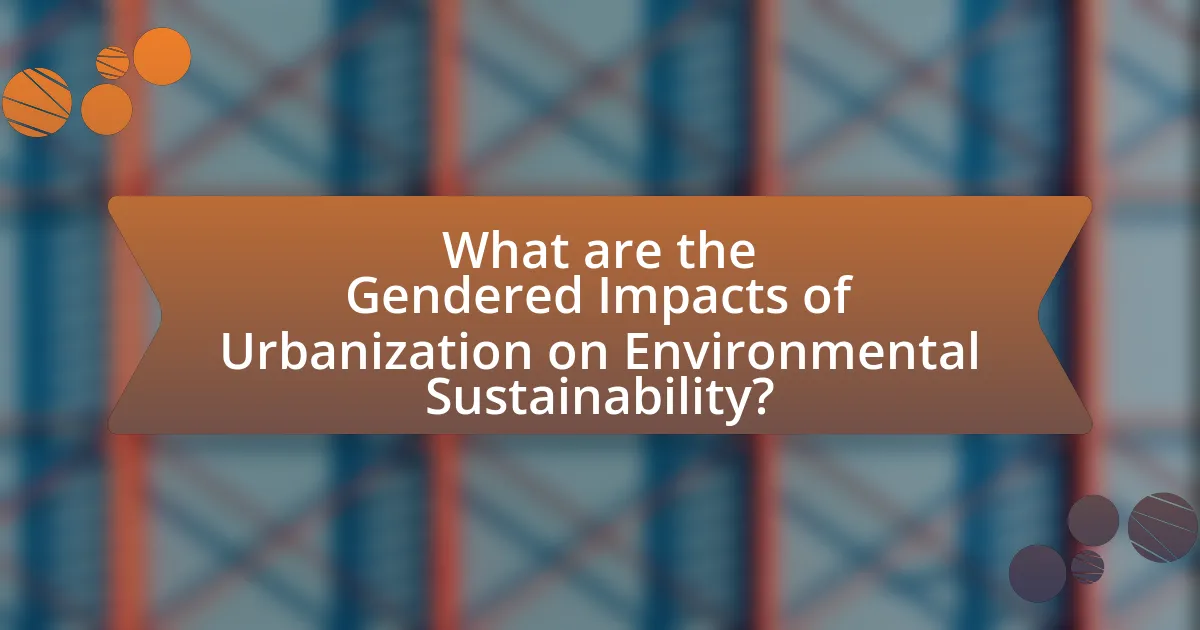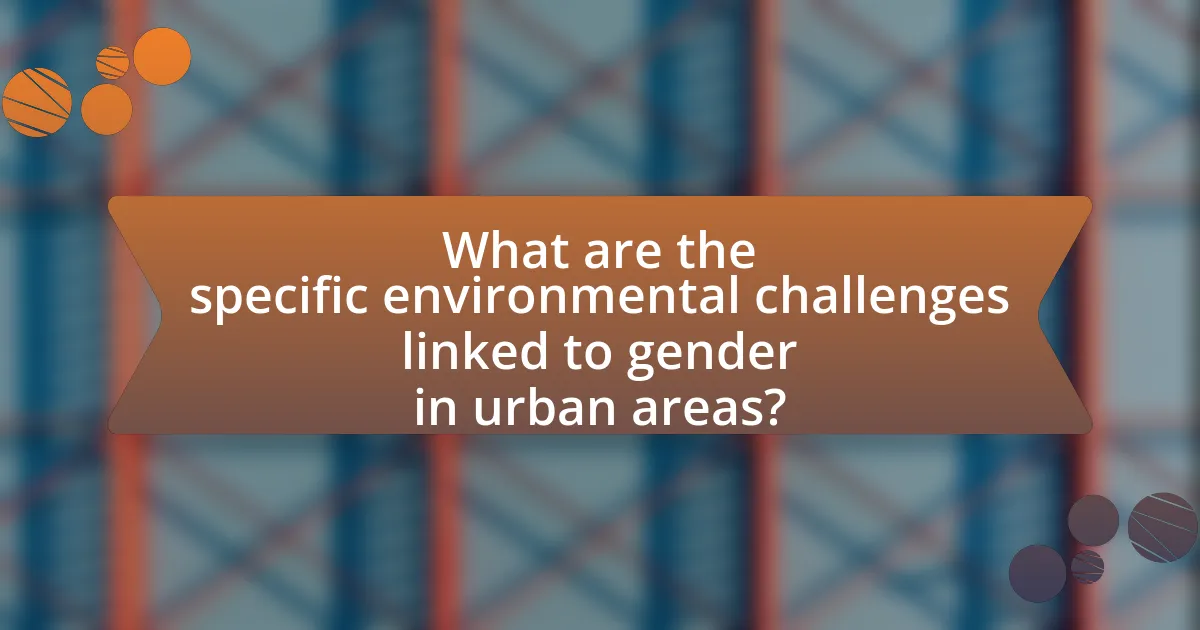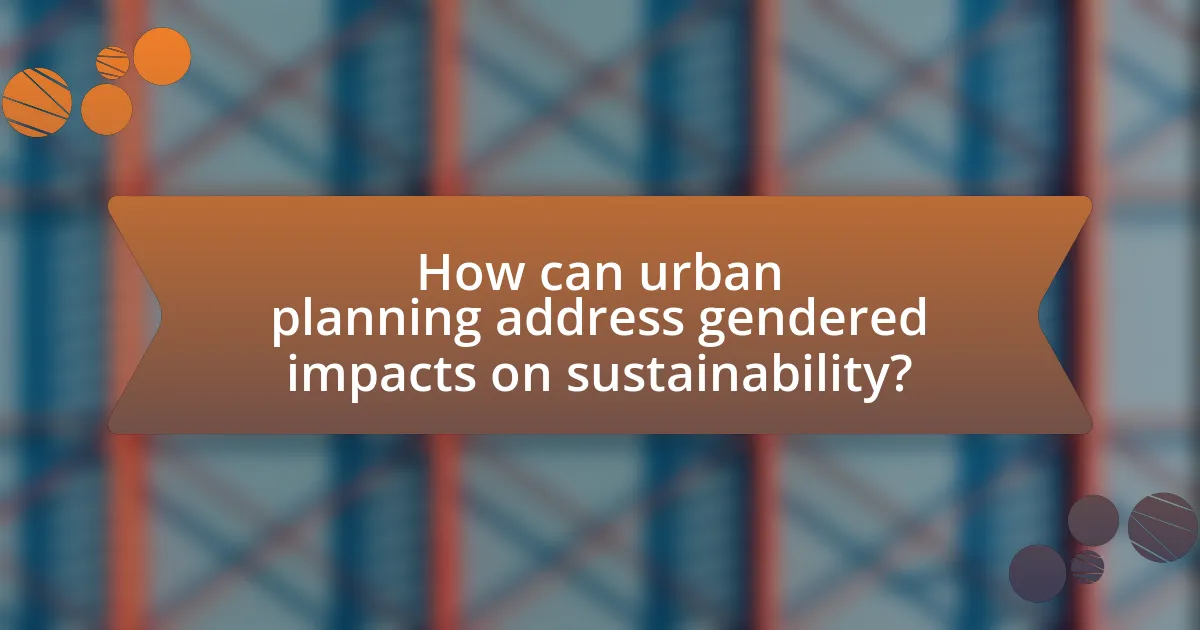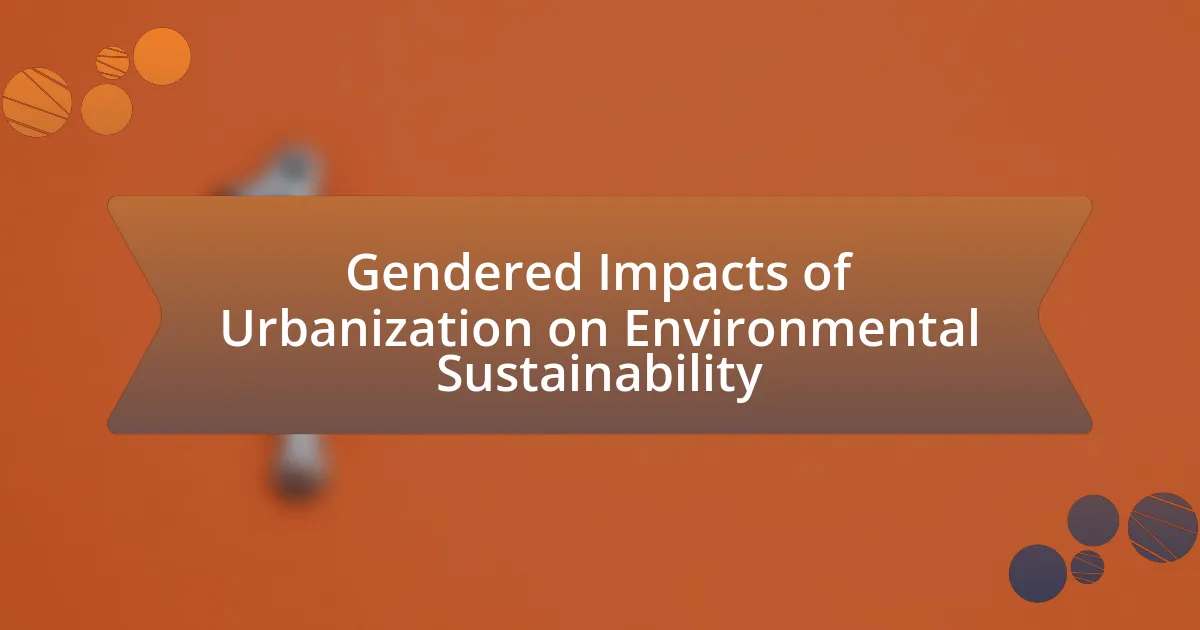The article examines the gendered impacts of urbanization on environmental sustainability, highlighting how urbanization affects resource access, decision-making, and vulnerability to environmental hazards differently for men and women. It discusses the specific challenges women face in urban environments, such as inadequate access to public services, safety concerns, and economic disparities, while also addressing how men experience urbanization through greater access to economic opportunities. The importance of integrating gender considerations into urban environmental policies is emphasized, as ignoring these factors can lead to ineffective sustainability efforts and exacerbate existing inequalities. The article further explores strategies for promoting gender equity in urban planning and the role of women in shaping sustainable urban environments.

What are the Gendered Impacts of Urbanization on Environmental Sustainability?
Urbanization has distinct gendered impacts on environmental sustainability, primarily affecting resource access, decision-making, and vulnerability to environmental hazards. Women often face greater challenges in accessing clean water, sanitation, and energy due to urban infrastructure that does not consider their specific needs, which can lead to increased environmental degradation. For instance, a study by the United Nations Development Programme highlights that women are disproportionately affected by climate change and urban pollution, as they are more likely to be responsible for household resource management. Additionally, women’s participation in urban planning and decision-making processes is often limited, resulting in policies that do not adequately address gender-specific environmental issues. This lack of representation can hinder sustainable urban development and exacerbate inequalities, ultimately impacting the overall effectiveness of environmental sustainability efforts.
How does urbanization affect different genders in urban settings?
Urbanization affects different genders in urban settings by creating distinct opportunities and challenges that vary based on gender roles and societal expectations. For instance, women often face increased risks of violence and harassment in urban areas, which can limit their mobility and access to resources. According to a UN-Habitat report, women in cities are more likely to experience gender-based violence, which is exacerbated by inadequate urban planning and lack of safe public spaces. Conversely, urbanization can provide women with greater access to education and employment opportunities, as cities tend to offer more diverse job markets. However, men may benefit from traditional employment roles that are more readily available in urban settings, such as construction and manufacturing jobs. This gender disparity in employment opportunities can lead to unequal economic benefits from urbanization, as highlighted in the World Bank’s Gender Equality and Development report, which states that gender gaps in labor force participation can hinder overall economic growth. Thus, urbanization has multifaceted impacts on genders, influencing their social, economic, and safety dynamics in urban environments.
What specific challenges do women face in urbanized environments?
Women in urbanized environments face specific challenges such as inadequate access to public services, safety concerns, and economic disparities. These challenges are exacerbated by urban planning that often overlooks women’s needs, leading to limited access to transportation, healthcare, and education. For instance, a study by the United Nations found that women are disproportionately affected by urban poverty, with 70% of the world’s poor being women, highlighting the economic inequalities they encounter in cities. Additionally, issues like gender-based violence in public spaces further hinder women’s mobility and participation in urban life, as reported by the World Health Organization, which states that one in three women globally experiences physical or sexual violence.
How do men experience the impacts of urbanization differently?
Men experience the impacts of urbanization differently primarily through their access to economic opportunities and social networks. Urbanization often leads to job creation in sectors such as construction and services, which tend to attract male workers more than female workers. For instance, a study by the International Labour Organization found that men are more likely to be employed in higher-paying jobs in urban areas, leading to greater economic benefits for them compared to women. Additionally, men may have more robust social networks that facilitate access to these opportunities, further enhancing their experience of urbanization. This gender disparity in employment and economic benefits highlights the distinct ways men navigate the urban landscape compared to women.
Why is it important to consider gender in urban environmental policies?
Considering gender in urban environmental policies is crucial because it ensures that the diverse needs and perspectives of all community members are addressed. Women and men often experience urban environments differently due to social roles, economic opportunities, and access to resources. For instance, research shows that women are more likely to be affected by environmental hazards, such as air pollution and lack of access to clean water, due to their roles in caregiving and household management. By integrating gender considerations, policies can promote equitable access to resources, enhance community resilience, and improve overall environmental sustainability. Studies indicate that gender-responsive policies lead to better outcomes in urban planning and resource management, ultimately benefiting the entire community.
What are the implications of ignoring gender in sustainability efforts?
Ignoring gender in sustainability efforts leads to ineffective policies and programs that fail to address the unique needs and contributions of different genders. This oversight can result in unequal access to resources, exacerbating existing inequalities and hindering community resilience. For instance, research by the United Nations Development Programme indicates that women are often responsible for managing natural resources in many communities, yet their voices are frequently excluded from decision-making processes. Consequently, this exclusion can lead to unsustainable practices that do not reflect the realities of all community members, ultimately undermining the overall effectiveness of sustainability initiatives.
How can gender-inclusive policies enhance environmental sustainability?
Gender-inclusive policies can enhance environmental sustainability by ensuring diverse perspectives and needs are integrated into environmental decision-making processes. Research indicates that women often possess unique knowledge and skills related to resource management, which can lead to more effective environmental practices. For instance, a study by the Food and Agriculture Organization found that when women are involved in agricultural decision-making, crop yields can increase by 20-30%, contributing to food security and sustainable land use. Additionally, gender-inclusive policies can promote equitable access to resources, reducing conflicts and fostering community cooperation in environmental initiatives. This holistic approach ultimately leads to more resilient and sustainable urban environments.

What are the specific environmental challenges linked to gender in urban areas?
Specific environmental challenges linked to gender in urban areas include unequal access to resources, vulnerability to climate change, and disparities in environmental decision-making. Women often face barriers in accessing clean water, sanitation, and energy, which are critical for health and well-being. For instance, a study by the United Nations Development Programme highlights that women in urban slums are disproportionately affected by inadequate infrastructure and pollution, leading to health risks. Additionally, women are more likely to be impacted by climate-related disasters due to their roles in caregiving and resource management, as noted in the Intergovernmental Panel on Climate Change reports. Furthermore, gender biases in governance can limit women’s participation in environmental policy-making, resulting in solutions that do not address their specific needs.
How does access to resources differ by gender in urban settings?
Access to resources in urban settings often differs significantly by gender, with women frequently facing greater barriers than men. Research indicates that women have less access to financial resources, land ownership, and decision-making power, which limits their ability to utilize urban resources effectively. For instance, a study by the World Bank found that women in urban areas are 30% less likely than men to own property, which directly impacts their access to housing and financial services. Additionally, women often bear the brunt of unpaid care work, restricting their time and opportunities to engage with available resources. This gender disparity in resource access not only affects individual livelihoods but also has broader implications for urban sustainability and development.
What role does gender play in access to clean water and sanitation?
Gender plays a significant role in access to clean water and sanitation, as women and girls often bear the primary responsibility for water collection in many communities. This responsibility can limit their access to education and economic opportunities, as they spend considerable time fetching water, which can be several hours each day. According to the United Nations, women and girls are responsible for water collection in 80% of households without access to water on premises, highlighting the gender disparity in water access. Furthermore, inadequate sanitation facilities disproportionately affect women, particularly during menstruation and childbirth, leading to health risks and social stigma. These factors illustrate how gender dynamics directly influence access to essential resources like clean water and sanitation.
How does gender influence access to green spaces and recreational areas?
Gender influences access to green spaces and recreational areas through social norms, safety concerns, and resource allocation. Research indicates that women often face greater barriers to accessing these spaces due to safety issues, such as fear of harassment, which can limit their willingness to visit parks or recreational areas, particularly during certain times of the day. A study by the University of California, Berkeley, found that women are less likely than men to use public parks due to concerns about personal safety, which directly impacts their access to these environments. Additionally, urban planning often reflects gender biases, with many cities prioritizing infrastructure that caters more to male-dominated activities, thereby limiting equitable access for women. This disparity in access can lead to unequal health and well-being outcomes, as green spaces are crucial for physical and mental health.
What are the gendered effects of urban pollution and waste management?
Urban pollution and waste management have distinct gendered effects, primarily impacting women and marginalized groups more severely than men. Women often bear the brunt of health issues related to pollution, as they are frequently responsible for household waste management and are more exposed to environmental hazards. For instance, studies indicate that women in urban areas are more likely to suffer from respiratory diseases due to poor air quality and inadequate waste disposal practices. Furthermore, women’s economic opportunities can be hindered by urban pollution, as they may spend more time managing waste and dealing with its consequences, limiting their participation in the workforce. Research from the United Nations Environment Programme highlights that women in low-income urban settings face increased vulnerability to pollution-related health risks, which exacerbates existing gender inequalities.
How do women and men experience air and water pollution differently?
Women and men experience air and water pollution differently due to biological, social, and economic factors. Women are often more vulnerable to the health impacts of pollution, as they may have different physiological responses and are more likely to be responsible for household water management, exposing them to contaminated water. For instance, studies indicate that women in low-income communities face higher risks of respiratory diseases from air pollution due to their roles in cooking and heating with solid fuels, which release harmful pollutants indoors. Additionally, women are more likely to suffer from waterborne diseases, as they often manage family health and nutrition, making them more susceptible to the effects of polluted water sources. In contrast, men may experience pollution differently, often being more exposed to outdoor air pollution through occupational hazards. Research shows that men are more likely to work in industries with higher pollution levels, leading to increased exposure to harmful substances. Thus, the gendered experiences of pollution highlight the need for targeted interventions that consider these differences.
What are the gender-specific impacts of inadequate waste management in cities?
Inadequate waste management in cities disproportionately affects women, primarily due to their roles in household management and caregiving. Women often bear the brunt of health risks associated with poor waste disposal, as they are more likely to be responsible for waste handling in domestic settings. For instance, exposure to hazardous waste can lead to increased rates of respiratory diseases and reproductive health issues among women.
Additionally, inadequate waste management can exacerbate gender inequalities by limiting women’s access to public spaces and resources. Women may face increased safety risks in areas with poor sanitation, which can restrict their mobility and participation in economic activities. Research indicates that in urban areas with inadequate waste management, women are more likely to experience social exclusion and economic disadvantage, as they are often tasked with managing waste in informal settings without adequate support or resources.
These gender-specific impacts highlight the need for inclusive waste management policies that consider the unique challenges faced by women in urban environments.

How can urban planning address gendered impacts on sustainability?
Urban planning can address gendered impacts on sustainability by integrating gender-sensitive approaches that consider the different needs and roles of men and women in urban environments. For instance, urban planners can conduct gender analyses to identify specific challenges faced by women, such as access to public transportation, safety in public spaces, and availability of childcare facilities. Research indicates that women often have different mobility patterns and responsibilities compared to men, which can affect their access to resources and opportunities. By incorporating these insights into planning processes, cities can create more inclusive and equitable environments that promote sustainability. For example, cities that have implemented gender-responsive planning, like Vienna, have seen improvements in public transport accessibility for women, leading to increased participation in the workforce and enhanced community well-being.
What strategies can be implemented to promote gender equity in urban planning?
To promote gender equity in urban planning, strategies such as inclusive stakeholder engagement, gender-sensitive data collection, and the integration of gender perspectives in policy-making should be implemented. Inclusive stakeholder engagement ensures that women and marginalized groups have a voice in the planning process, which is crucial for addressing their specific needs and priorities. Gender-sensitive data collection involves gathering disaggregated data to understand how different genders experience urban environments, enabling planners to make informed decisions. Furthermore, integrating gender perspectives in policy-making ensures that urban policies and projects consider the diverse needs of all genders, leading to more equitable outcomes. Research indicates that cities that adopt these strategies can improve overall urban sustainability and social equity, as seen in initiatives from cities like Barcelona and Stockholm, which have successfully implemented gender-responsive urban planning frameworks.
How can community engagement enhance gender-sensitive urban policies?
Community engagement enhances gender-sensitive urban policies by ensuring that the voices and needs of diverse gender groups are incorporated into the planning and decision-making processes. This participatory approach allows for the identification of specific challenges faced by different genders in urban environments, such as safety concerns, access to resources, and public services. Research indicates that cities with active community involvement in policy-making are more likely to implement effective gender-sensitive measures, as seen in the case of the UN-Habitat’s “Gender in Urban Planning” initiative, which emphasizes local input to create inclusive urban spaces. By integrating community feedback, urban policies can be tailored to address the unique experiences and requirements of all genders, ultimately leading to more equitable and sustainable urban development.
What role do women play in shaping sustainable urban environments?
Women play a crucial role in shaping sustainable urban environments by actively participating in decision-making processes, advocating for community needs, and implementing sustainable practices. Research indicates that women often prioritize environmental sustainability in urban planning, emphasizing the importance of green spaces, public transportation, and community engagement. For instance, a study by the United Nations found that when women are involved in urban planning, cities tend to adopt more inclusive and sustainable policies, leading to improved quality of life and environmental outcomes. Additionally, women frequently lead grassroots movements that promote sustainable practices, such as waste reduction and resource conservation, further influencing urban sustainability initiatives.
What best practices can cities adopt to improve gendered environmental outcomes?
Cities can adopt inclusive planning and policy frameworks to improve gendered environmental outcomes. By integrating gender perspectives into urban development, cities can ensure that the needs and contributions of all genders are recognized and addressed. For instance, research shows that women often have different environmental priorities and experiences, such as access to clean water and safe public spaces. Implementing gender-responsive budgeting can allocate resources effectively to address these specific needs, leading to more equitable environmental outcomes. Additionally, engaging women in decision-making processes related to environmental policies has been shown to enhance community resilience and sustainability, as evidenced by initiatives in cities like Barcelona and Nairobi, where women’s involvement has led to improved urban green spaces and waste management systems.
How can cities measure the effectiveness of gender-inclusive sustainability initiatives?
Cities can measure the effectiveness of gender-inclusive sustainability initiatives by utilizing quantitative and qualitative metrics that assess both participation and outcomes. For instance, cities can track the number of women involved in decision-making processes related to sustainability projects, as well as the specific impacts of these initiatives on women’s quality of life, such as access to resources and services. Research indicates that gender-inclusive policies lead to improved environmental outcomes; for example, a study by the World Bank found that women’s participation in community management of natural resources significantly enhances sustainability efforts. Additionally, cities can conduct surveys and focus groups to gather feedback from women on their experiences and perceptions of sustainability initiatives, ensuring that the initiatives address their specific needs and challenges.
What are some successful case studies of gender-sensitive urban sustainability efforts?
Successful case studies of gender-sensitive urban sustainability efforts include the Women’s Empowerment in the Ecological Restoration of Urban Areas project in Brazil, which engaged women in reforestation efforts, leading to improved community resilience and biodiversity. Another example is the Gender-Responsive Urban Climate Action Plan in Mexico City, which integrated gender considerations into climate adaptation strategies, resulting in enhanced participation of women in decision-making processes and improved access to resources. These initiatives demonstrate the effectiveness of incorporating gender perspectives in urban sustainability, as evidenced by increased community engagement and environmental outcomes.
What practical steps can individuals take to advocate for gender equity in urban sustainability?
Individuals can advocate for gender equity in urban sustainability by actively participating in community planning processes. Engaging in local government meetings allows individuals to voice the unique needs of women and marginalized groups, ensuring their perspectives are included in urban development projects. Research shows that inclusive planning leads to more equitable resource distribution and improved environmental outcomes, as highlighted in the UN-Habitat report on gender and urbanization. Additionally, individuals can support organizations that focus on women’s rights in environmental policy, thereby amplifying their impact. By promoting educational initiatives that raise awareness about the intersection of gender and sustainability, individuals can foster a more informed community that prioritizes gender equity in urban sustainability efforts.
